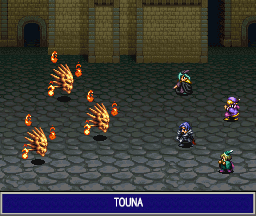The Initial Release
Treasure of the Rudras is a traditional RPG by Squaresoft, release for the Super Nintendo in Japan in 1996. Its Japanese name is Rudora no Hihou (or Rudra no Hihou). It was Squaresoft's last RPG released for the Super Nintendo. As such, the game could be mistaken for a PlayStation 1 RPG, as it was an example of Squaresoft's highest peak of skill at making 16-bit RPGs.
You have 15 days to save the world! The story is divided into three major scenarios, each with a different main character: the soldier Sion, the priestess Riza, and the archaeologist Surlent. You're free to play the scenarios in any order, and may even leave one storyline to follow that of another character for a time. The actions of the characters in one location and time may affect the others, as well, both in the general story and in gameplay. For example, if one group of characters leaves a sacred relic somewhere, another character may come and find it on a later day in their part of the game. Pretty cool, huh? After completing all three scenarios, you must take on a fourth, featuring the roving thief Dune and the heroes from the previous three chapters in their final confrontation with the game's major villains.
The English Fan Translation
Naturally, a game of this caliber that never officially left Japan received a fan-based English translation for us to enjoy. In 2006, Aeon Genesis Translations was the group who released the complete English fan translation. Treasure of the Rudras' English translation had a tough journey, having to survive the politics of the classic gaming/emulation scene.
Let's rewind to 1998. At this time, video game emulation and fan translated video games were growing in popularity. Word quickly spread of all the awesome Squaresoft RPGs that were never released in North America. Us gamers pushed for an English translation for each one.
Unfortunately, Treasure of the Rudras attracted a bad reputation. For some reason, English/Japanese bilingual RPG fans who had played the game went around spreading the word that the storyline was terrible. Additionally, people were judging the game at face value, spreading the word that it was overrated.
Hence, Treasure of the Rudras became the black sheep among the untranslated RPGs. This negative reputation kept translation groups away from it. To make matters worse, the few ROM hackers who did try translating Treasure of the Rudras couldn't figure out how to crack its complex mantra system. For years, Treasure of the Rudras was pushed aside and ignored. Those who brought up the game in emulation communities (like me, lol) were ridiculed for showing interest in 'yet another overrated Squaresoft RPG'. It's the Internet being the Internet.
Thankfully, Gideon Zhi of Aeon Genesis Translations took up the mantle. He cracked the mantra system and gave us a quality English translation in 2006. The game's unfair negative reputation suddenly vanished overnight. After people took the time to play it, everyone realized “Hey, this game is actually good!” Treasure of the Rudras was one of the last of the great Squaresoft RPGs that we were patiently waiting to be fan translated. Live-A-Live was the last one (released in 2008 by AGTP).



